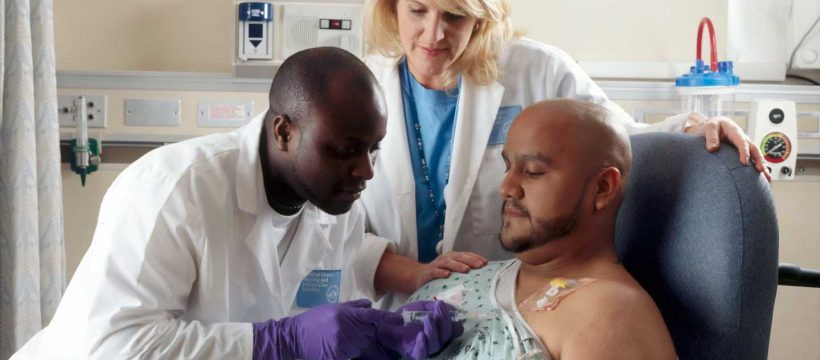
Numerous studies have shown that people from racial and ethnic minority groups are underrepresented in clinical trials of new medical treatments for multiple myeloma. A study published today in the Blood Journal suggests that, for clinical trials of new treatments for multiple myeloma (a type of blood cancer), one reason for this underrepresentation may be that the parameters set to determine who can—and cannot—enroll in trials disproportionately exclude minority patients.
“Our study suggests that, in multiple myeloma clinical trials, some eligibility criteria specified in trial protocols may be contributing to racial and ethnic disparities in enrollment,” said Bindu Kanapuru, MD, a medical officer with the U.S. Food and Drug Administration (FDA) Center for Drug Evaluation and Research and first author of the study.
“We found that, compared with white patients, those who were Black or of other races (American Indians, Alaska Natives, Native Hawaiians, and other Pacific Islanders) were more likely to be deemed ineligible for trial enrollment.”
All clinical trials set criteria that patients must satisfy to enroll, she said. For example, patients may be required to have already been treated unsuccessfully with specific medications, received a minimum number of prior treatments, have blood cell counts above or below a specified level, or not have other health conditions such as heart disease or a history of asthma.
“To our knowledge, this is the first study to evaluate trial eligibility criteria as a potential barrier to the enrollment of patients from underrepresented racial and ethnic subgroups into clinical trials for multiple myeloma,” Dr. Kanapuru said.
Multiple myeloma is the second most common type of blood cancer in the United States, with about 34,500 new cases diagnosed in 2022, she said. In the United States, Black people are twice as likely as whites to be diagnosed with multiple myeloma and have the highest rates of death from the disease, followed by American Indians and Alaska Natives.
Yet Black patients comprise less than 5% of those enrolled in clinical trials that are intended to lead to the approval of new treatments for multiple myeloma, Dr. Kanapuru said, while the proportion of American Indians and Alaska Natives who are enrolled is even smaller.
For this study, she and her colleagues analyzed information submitted to the FDA for 9,325 patients who were evaluated for enrollment in 16 clinical trials of novel treatments for multiple myeloma that were performed between 2006 and 2019. Twelve percent of the patients were evaluated in the United States and 88% in other countries.
Eighty-three percent of the patients were white, 7% Asian, 4% Black, 4% of unknown race, and 2% of “other” races (which included American Indians, Alaska Natives, Native Hawaiians, and other Pacific Islanders). Four percent of patients reported being of Hispanic ethnicity.
Overall, 17% of the evaluated patients were deemed ineligible for trial enrollment. The ineligibility rate was highest for Black patients (24%), followed by those of ‘other’ races (23%). Seventeen percent of white patients were deemed ineligible. Patients of Asian heritage had the lowest rate of ineligibility (11%).
Black patients were most likely to be considered ineligible because of their blood cell counts or because they had not previously received specific treatments or a minimum number of prior treatments. White patients were most likely to be ineligible due to not meeting specific disease-related criteria.
“Previous studies in patients with multiple myeloma have shown that ‘normal’ levels of neutrophils (a type of white blood cell) may be lower among Black patients than whites and that Black patients have higher rates of anemia (a shortage of red blood cells) than whites,” Dr. Kanapuru said. “This suggests that trials should set criteria for blood counts that take racial and ethnic variations into account.”
Other studies, she said, have shown that Black patients with multiple myeloma are less likely to receive certain standard therapies. “This can result in a cycle in which Black patients aren’t enrolled in trials because they haven’t previously received certain treatments, which in turn means there’s a lack of evidence to show whether or not those treatments are effective in Black patients.”
One notable finding from the current study is that a subset of Black patients were enrolled in trials despite not meeting some of the eligibility criteria such as low blood counts, said Dr. Kanapuru. “This suggests that some physicians may already be factoring in racial and ethnic variations in things like blood counts when they evaluate patients for trial eligibility,” she said. “While this is encouraging, the actions of individual physicians are unlikely to be enough to solve the problem of racial and ethnic disparities in trial enrollment.”
The FDA has published guidance for industry on strategies for increasing the enrollment of underrepresented racial and ethnic groups in clinical trials, she said.
A limitation of the study findings, she said, is that because so few patients from racial and ethnic minorities were evaluated for trial enrollment, the researchers could not perform a rigorous statistical analysis to determine with greater precision why patients were deemed ineligible.
“The very small numbers of minority patients who were evaluated makes it impossible for us to draw definitive conclusions,” she said. “However, we hope that our study will raise awareness of this issue.”
More information:
Bindu Kanapuru et al, Eligibility criteria and Enrollment of a Diverse Racial and Ethnic population in Multiple Myeloma Clinical Trials, Blood Journal (2023). DOI: 10.1182/blood.2022018657
Journal information:
Blood
Source: Read Full Article
